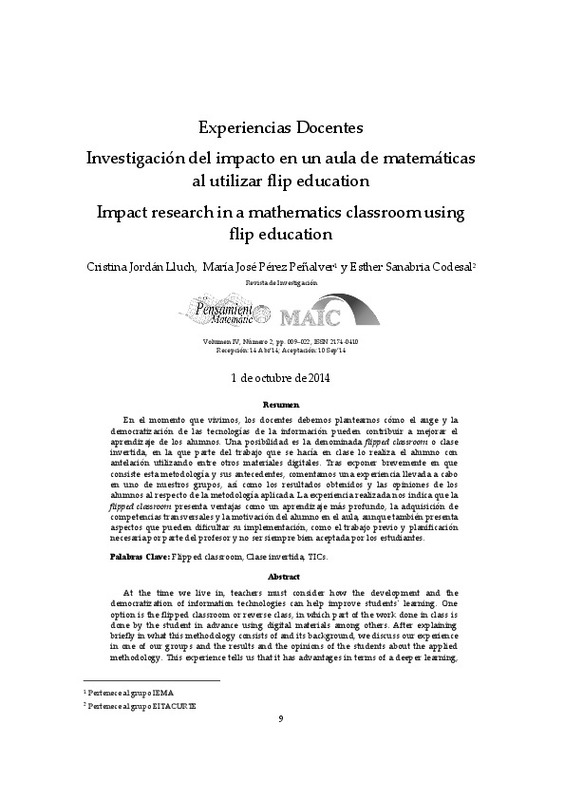JavaScript is disabled for your browser. Some features of this site may not work without it.
Buscar en RiuNet
Listar
Mi cuenta
Estadísticas
Ayuda RiuNet
Admin. UPV
Investigación del impacto en un aula de matemáticas al utilizar flip education
Mostrar el registro sencillo del ítem
Ficheros en el ítem
| dc.contributor.author | Jordan Lluch, Cristina
|
es_ES |
| dc.contributor.author | Pérez Peñalver, María José
|
es_ES |
| dc.contributor.author | Sanabria Codesal, Esther
|
es_ES |
| dc.date.accessioned | 2015-04-23T12:17:18Z | |
| dc.date.available | 2015-04-23T12:17:18Z | |
| dc.date.issued | 2014-10 | |
| dc.identifier.issn | 2174-0410 | |
| dc.identifier.uri | http://hdl.handle.net/10251/49189 | |
| dc.description.abstract | [EN] At the time we live in, teachers must consider how the development and the democratization of information technologies can help improve students' learning. One option is the flipped classroom or reverse class, in which part of the work done in class is done by the student in advance using digital materials among others. After explaining briefly in what this methodology consists of and its background, we discuss our experience in one of our groups and the results and the opinions of the students about the applied methodology. This experience tells us that it has advantages in terms of a deeper learning, to the acquisition of generic skills and student motivation in the classroom but it also has aspects that may hinder its implementation as it requires a lot of preparatory work and planning by teacher and it is not always well accepted by students. | es_ES |
| dc.description.abstract | [ES] En el momento que vivimos, los docentes debemos plantearnos cómo el auge y la democratización de las tecnologías de la información pueden contribuir a mejorar el aprendizaje de los alumnos. Una posibilidad es la denominada flipped classroom o clase invertida, en la que parte del trabajo que se hacía en clase lo realiza el alumno con antelación utilizando entre otros materiales digitales. Tras exponer brevemente en que consiste esta metodología y sus antecedentes, comentamos una experiencia llevada a cabo en uno de nuestros grupos, así como los resultados obtenidos y las opiniones de los alumnos al respecto de la metodología aplicada. La experiencia realizada nos indica que la flipped classroom presenta ventajas como un aprendizaje más profundo, la adquisición de competencias transversales y la motivación del alumno en el aula, aunque también presenta aspectos que pueden dificultar su implementación, como el trabajo previo y planificación necesaria por parte del profesor y no ser siempre bien aceptada por los estudiantes. | |
| dc.language | Español | es_ES |
| dc.publisher | Universidad Politécnica de Madrid | es_ES |
| dc.relation.ispartof | Pensamiento Matemático | es_ES |
| dc.rights | Reconocimiento - No comercial - Compartir igual (by-nc-sa) | es_ES |
| dc.subject | Flipped classroom | es_ES |
| dc.subject | Clase invertida | es_ES |
| dc.subject | TICs | es_ES |
| dc.subject | Inverted class | es_ES |
| dc.subject.classification | MATEMATICA APLICADA | es_ES |
| dc.title | Investigación del impacto en un aula de matemáticas al utilizar flip education | es_ES |
| dc.title.alternative | Impact research in a mathematics classroom using flip education | |
| dc.type | Artículo | es_ES |
| dc.rights.accessRights | Abierto | es_ES |
| dc.contributor.affiliation | Universitat Politècnica de València. Departamento de Matemática Aplicada - Departament de Matemàtica Aplicada | es_ES |
| dc.description.bibliographicCitation | Jordan Lluch, C.; Pérez Peñalver, MJ.; Sanabria Codesal, E. (2014). Investigación del impacto en un aula de matemáticas al utilizar flip education. Pensamiento Matemático. IV(2):9-22. http://hdl.handle.net/10251/49189 | es_ES |
| dc.description.accrualMethod | S | es_ES |
| dc.relation.publisherversion | http://www2.caminos.upm.es/Departamentos/matematicas/revistapm/index4_vol_IV_numero2.html | es_ES |
| dc.description.upvformatpinicio | 9 | es_ES |
| dc.description.upvformatpfin | 22 | es_ES |
| dc.type.version | info:eu-repo/semantics/publishedVersion | es_ES |
| dc.description.volume | IV | es_ES |
| dc.description.issue | 2 | es_ES |
| dc.relation.senia | 273728 |






